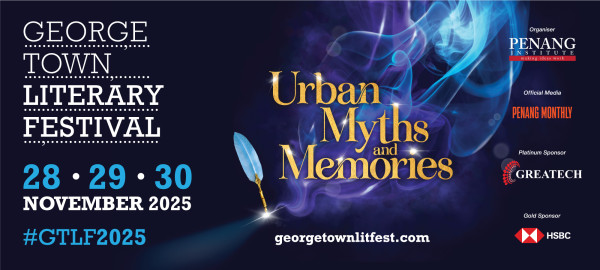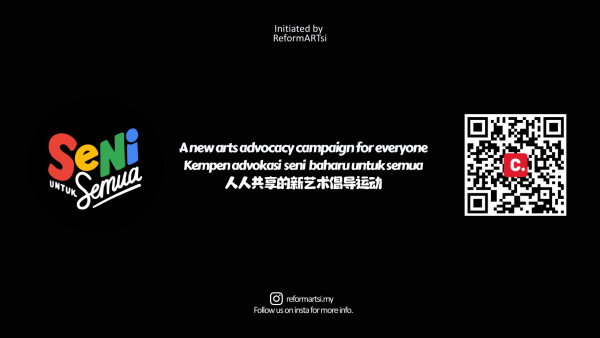
Cast members from left to right: Sidhart Joe Dev, Karthigesan, Nandagopall and Perassath in one of the final sequences of the show. Photo Credit : Sherwynd Kessler Studio and George Town Festival 2024
(This blog post originated from KAYPOH. For the full article, please visit KAYPOH's website.)
Review by Nur Hilyati Ramli & Muha Mesri
SUMMARY: "They All Die At the End," presented by Theatresauce, is a two-hour play featuring an all-male Indian ensemble. As part of Georgetown Festival 2024, the show ran from July 26-28. It uses poetry, music, and visuals to delve into the Malaysian Indian experience, exploring themes from the past, present, and imagined futures.
They All Die At The End (TADATE), directed by Dhinesha Karthigesu at the Georgetown Festival 2024, ambitiously seeks to explore the multifaceted experiences of Malaysian Indian men in 2024. Through 22 short acts spanning a two-and-a-half-hour performance, the show delves into complex themes of identity, societal expectations, and familial relationships. Despite its profound intent, the production struggles to resonate with a broader audience due to several critical shortcomings in its execution.
Karthigesu’s direction aims to paint a comprehensive picture of contemporary issues faced by Malaysian Indian men, employing various storytelling techniques, including projections, music, and movement, to bridge and summarise each act. Projections of sea waves, written quotations, and moving cubes are used to enhance visual storytelling and provide transitions between acts. While these elements are visually engaging, they sometimes contribute to a disjointed experience and disrupt the narrative flow. The repetitive use of sea wave projections and different quotations to summarise each act, coupled with the extended duration of these interludes with no other action on stage, ultimately hinders the overall fluidity and continuity of the performance. Perhaps, by shortening the duration of these interludes could help maintain the audience's engagement and enhance the coherence of the narrative.
The performance begins with a pre-show segment where performers struggle to tie a Veshti (a piece of cloth wrapped around the legs), transitioning into the interactive “Hero Entry” where the audience sings the national anthem while a projection displays news reports on the political and social issues affecting Indian people in Malaysia. The audience then engages with projections on racial profiling and police encounters, with questions prompting them to reflect on their own experiences. This initial choice sets a tone of immersion, suggesting a participatory experience. However, as the performance progresses, these interactive elements occasionally feel forced, disrupting rather than enhancing the immersion.
Interactive theatre is designed to engage audiences in real-life political and moral debates, transforming them into active participants and creating a heightened sense of reality. Augusto Boal’s Forum Theatre, a pioneering example of this approach, aims to help audiences confront their "internal oppressions" by involving them directly in the performance. In TADATE, the intention behind incorporating interactive elements was to deepen audience involvement by prompting reflections on personal experiences of oppression and societal issues. However, the execution of these interactive segments often falls short of this goal. For example, questions such as "Will you leave Malaysia if given a choice?" do not always align clearly with the subsequent scenes, leading to a disconnection between the interactions and the overall narrative. This lack of coherence disrupts the flow and undermines the thematic content, detracting from the effectiveness of the interactive approach. Furthermore, the inconsistency in how these elements are presented further diminishes their potential to engage the audience meaningfully and to prompt the reflective engagement that could enhance the audience connection with the issues of the performance.
Cast members from left to right: Perassath, Nandagopall, Vignesh and Karthigesan in one of the intense seen on stage. Photo Credit : Sherwynd Kessler Studio and George Town Festival 2024
The production’s narrative structure is divided into two distinct sections. The first section introduces themes of identity and societal expectations through acts such as “Paar,” where two schoolboys fall in love; “How to Tie a Veshti,” featuring a humorous take on traditional attire; and “Father & Son,” which explores discussions about Hindu gods. Acts like “Batu Caves,” depicting a boy lost during Thaipusam, and “Wishes,” where characters imagine conversations with their fathers, further contribute to these themes. After a 15 minute intermission, the second section delves into more personal and collective narratives. “Childhood” contrasts video game innocence with adult responsibilities, while “Therapist Appa” features a video call and then switch to stage acting discussing mental health and family expectations. “Migration” provides historical context on Indian migration to Malaya, and “Bros at Funeral” highlights family tensions over debt and inheritance. Subsequent acts like “Heartbreak,” “Crabs,” and “Missed Calls” explore themes of love, competition, communication, and cultural significance.
However, the thematic exploration in this performance often lacks depth and coherence, leading to a superficial engagement with the issues at hand. This deficiency impacts the overall structure of the performance, rendering it random and disjointed. To create a cohesive and impactful experience, a more deliberate arrangement of the scenes is necessary, prioritising their relevance and contribution to the overarching narrative.

The cast of “They All Die At The End” from left to right: Perassath, Karthigesan, Vighnesh, Sidhart Joe Dev and Nandagopall presenting the Indian migration to Malaya sequence. Photo Credit : Sherwynd Kessler Studio and George Town Festival 2024
Certain scenes, such as those featuring entire songs in “Heartbreak”, “Mamak” and “Club Burden,” could be omitted or shortened to maintain narrative focus. By concentrating on scenes like “Paar,” “Roadblock,” “Wishes,” “Childhood,” and “Therapist Appa,” the production could more effectively address core issues facing the Indian community in Malaysia, allowing the audience to engage more deeply with the performance. For instance, the “Roadblock” scene, which powerfully illustrates the community’s experiences with racial profiling and police brutality, including the tragic deaths of five individuals in custody, should serve as the show’s thematic fulcrum. This scene effectively addresses urgent societal issues and has the potential to set a high degree of intensity for the rest of the performance.
Despite the innovative use of projections and audience interaction, the production's portrayal does not effectively convey the intensity of the characters' struggles. The visual and movement choices lack the provocative impact needed to evoke strong emotional responses from the audience. Consequently, the performance falls short of immersing the audience in the characters’ experiences or eliciting deep sympathy for the issues portrayed. For instance, scenes like “Wishes,” “Childhood,” “Devalaram,” “Intergenerational Trauma” and “Crabs” would benefit from increased intensity, pace, and sharpness in the movements. This enhancement would help the audience better resonate with the depicted struggles, facilitating a more profound cognitive and emotional reflection on the issues presented. Overall, refining the narrative structure and focusing on the most impactful scenes can transform the performance into a cohesive and resonant exploration of the Malaysian Indian community’s challenges and triumphs.......(Continue reading)

-Large-web.jpg)

-web.jpg)


